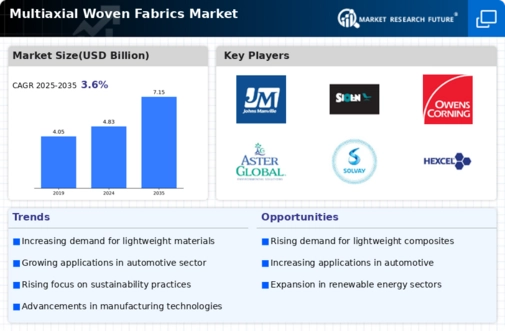Rising Demand in Aerospace Sector
The Multiaxial Woven Fabrics Market is experiencing a notable surge in demand from the aerospace sector. This growth is primarily attributed to the increasing need for lightweight and high-strength materials that can enhance fuel efficiency and performance. Multiaxial woven fabrics, known for their superior mechanical properties, are being increasingly utilized in aircraft components, leading to a projected market growth rate of approximately 5% annually. As aerospace manufacturers seek to reduce weight while maintaining structural integrity, the adoption of these advanced materials is likely to expand, thereby driving the Multiaxial Woven Fabrics Market forward.
Expansion in Automotive Applications
The automotive industry is witnessing a significant transformation, with a growing emphasis on lightweight materials to improve fuel efficiency and reduce emissions. The Multiaxial Woven Fabrics Market is poised to benefit from this trend, as these fabrics are increasingly used in vehicle components such as body panels and interior structures. The market for automotive composites is expected to reach USD 30 billion by 2026, with multiaxial woven fabrics playing a crucial role in this growth. As manufacturers strive to meet stringent regulatory standards, the demand for these innovative materials is likely to escalate, further propelling the Multiaxial Woven Fabrics Market.
Increased Investment in Renewable Energy
The shift towards renewable energy sources is creating new opportunities for the Multiaxial Woven Fabrics Market. Wind energy, in particular, is driving demand for advanced composite materials used in turbine blades. These fabrics offer the necessary strength-to-weight ratio and durability required for high-performance applications. The wind energy sector is projected to grow at a compound annual growth rate of 8% through 2030, which could significantly impact the Multiaxial Woven Fabrics Market. As investments in renewable energy continue to rise, the need for innovative materials like multiaxial woven fabrics is expected to increase, fostering market expansion.
Growing Awareness of Environmental Sustainability
The increasing awareness of environmental sustainability is influencing the Multiaxial Woven Fabrics Market. Manufacturers are under pressure to adopt eco-friendly practices and materials, leading to a rise in the development of sustainable multiaxial woven fabrics. These fabrics, often made from recycled or bio-based materials, are gaining traction in various industries, including construction and consumer goods. The market for sustainable textiles is projected to grow significantly, with a focus on reducing carbon footprints and promoting circular economy principles. As consumers and businesses alike prioritize sustainability, the Multiaxial Woven Fabrics Market is likely to evolve to meet these demands.
Technological Innovations in Manufacturing Processes
Technological advancements in manufacturing processes are reshaping the Multiaxial Woven Fabrics Market. Innovations such as automated weaving techniques and advanced resin infusion methods are enhancing production efficiency and product quality. These developments not only reduce manufacturing costs but also enable the production of complex geometries that were previously unattainable. As manufacturers adopt these cutting-edge technologies, the market is likely to witness an increase in the variety and performance of multiaxial woven fabrics. This evolution in manufacturing is expected to attract new applications and clients, thereby stimulating growth within the Multiaxial Woven Fabrics Market.





















Leave a Comment